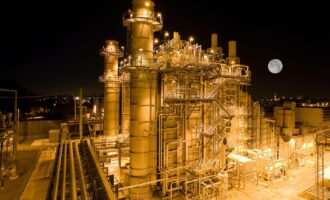Aluminium car body parts pose lubrication challenges
By Hank Hogan
Aluminium, the stuff of easy-to-crush cans, is increasingly found in car body parts. The trend represents an opportunity and a challenge for lubricants. Lubricants are needed that can withstand higher pressures and temperatures during metal forming.
Alloys of aluminium have been used for years in high-performance cars because they are strong enough to replace steel, but are much lighter. As a result, vehicles accelerate faster and handle better, advantages that offset any increase in material and manufacturing costs. Now aluminium alloys are appearing in mass-market vehicles, to further boost fuel economy by decreasing vehicle weight. A 100-kilogram weight reduction can reduce fuel consumption by half a litre per 100 kilometres of travel.

But, actually forming the alloys into car body parts places greater demands on lubricants. “As the sheet material has a higher strength, then the pressure and temperature also increase. Thus, the lubricant must have additives that allow the lubricant to perform well under those conditions,” said Taylan Altan at an Afton Chemical-sponsored talk during the annual meeting of the Society of Tribologists & Lubrication Engineers in Dallas, Texas, U.S.A. in May. As the director of the Center for Precision Forming in Columbus, Ohio, U.S.A., Altan researches what is needed to economically stamp out millions of hoods, door panels, trunk covers and other car body parts made from aluminium and other high strength materials. That can be challenging, due to the properties of the materials.
For instance, Al 7075 is an aluminium alloy with roughly the same tensile strength as stainless steel; it can undergo an elongation of less than 10% before fracturing from the strain. In contrast, steel can stretch many times further, or more than 50%, before fracturing. Thus, manufacturing processes that work well with mild-strength stainless steel may not be suitable for high-strength materials, as these typically stretch much less before cracking.
But the use of aluminium can reduce the weight of a vehicle by 30 to 40%, according to Altan. This can be seen by comparing high-end luxury cars from Mercedes- Benz, BMW and Audi. Going from an average aluminium content of 15% to about 90% reduced the average weight from about 95 kilograms per square meter (kg/m2) to about 70 kg/m2.
The need for improved and less expensive aluminium alloy body part manufacturing solutions is becoming more urgent because the technology is moving into the mass market, lower price point vehicles. For example, the new 2015 F-150 pick-up from the Ford Motor Co. of Dearborn, Mich., U.S.A. will become part of the bestselling pick-up truck line-up in North America. However, this year’s vehicle body is 95% aluminium, a change from the 2014 model that yields a weight savings of nearly 320 kilograms (kg).
“Light weighting lets our customer do more with the truck,” said Mike Levine, a spokesperson for Ford’s truck division. Levine listed towing, hauling, acceleration, braking and fuel economy as benefitting from higher aluminium content.
The F-150 may be the first of many mainstream consumer vehicles with significant aluminium alloy content. According to a 2014 study based on a survey of car and truck makers by Drucker Worldwide, the use of sheet aluminium for vehicle bodies in North America will grow 20-fold from 2012 to 2025, reaching a projected 1.8 billion kg. From 2012 to 2015, the average weight increased by 20 kg. per vehicle, Drucker reported.
“Aluminium-bodied cars and trucks are coming in a big way – and soon. Consumers won’t visibly notice a different metal under the paint, but they’ll see greater savings at the gas pump and experience better performance and handling at the wheel,” said Tom Boney, chairman of the Aluminum Transportation Group, which commissioned the study. This trade group is part of the Aluminum Association, which supports higher use of aluminium in many applications. In gearing up for F-Series sales that may top 700,000 vehicles this year, Ford made changes to its Dearborn and Kansas City, Mo., U.S.A. truck plants. For instance, the company invested in 500 new robots and installed new press lines to stamp out different types of highstrength, military-grade aluminium alloys, Levine said. The company also created aluminium capable body shops to handle parts repair.
There have been reports that repairs to aluminium body parts are more expensive and difficult than steel parts. However, the new F-150’s modular structure actually makes repairs easier, said Levine. Also, aluminium alloy body parts are not more expensive, he said. “Most exterior body panels have identical replacement costs to the outgoing 2014 F-150 steel body panels.”
In manufacturing those body parts, the typical starting point is a sheet of metal, which is then formed by tooling it into the correct shape. For example, the process may involve pressing up the edges of the sheet while forcing the middle down, with a lubricant making this deformation easier. The strength of the material plays a role, as does any surface coating. Other important parameters are the viscosity and film thickness of the lubricant, as well as the stability of these characteristics under pressure and at certain temperatures. Researchers at the Center for Precision Forming are looking beyond lubricants to find the best recipe for manufacturing high-strength materials. For instance, rams are used to force the tooling into the metal. Researchers are attempting to discover the optimum speed that should be used.
They also are looking at completely different ways to stamp metal parts. One option is warm forming. Unlike cold stamping, manufacturers would heat up the sheet metal to make it easier to form into the proper shape. For instance, the metal may be worked at 200 degrees Celsius (C) or higher, instead of at room temperature. “In warm forming, of course we need lubricants that can perform at the elevated temperatures used in this process,” Altan said.
As part of its research, the centre is developing tests to better evaluate lubricants. One involves cup-drawing tests, which Altan said gave the best results in gauging the lubricant’s effectiveness. This test begins with a blank sheet of metal, into which a punch is pushed. Lubricants are measured by how much deep drawing force the holder can take before cup formation fails, due to metal fracturing. Values reported so far show that blank holder force can measure 30 or more metric tonnes. These preliminary results indicate that it may be possible to use this test to distinguish between various lubricants.
Aluminium is only one of the new materials being evaluated. Others include high-strength steel, alloys of magnesium, fiber-reinforced plastic and carbon fiber. Each presents its own opportunities for light weighing. Each could also generate its own lubricant and manufacturing challenges.
At the same time, it’s important to keep in mind that the material serves the car and its buyer — not the other way around. Thus, a manufacturer may have one vehicle with high aluminium content, like the 2015 Ford F-150. However, this does not mean that the rest of its products will inevitably move towards a higher aluminium content. “We treat each vehicle on a case-by-case basis, applying the right material at the right time to improve efficiency and performance,” said Levine.







